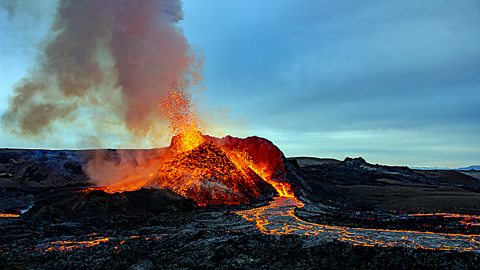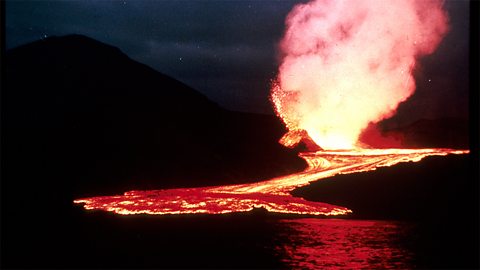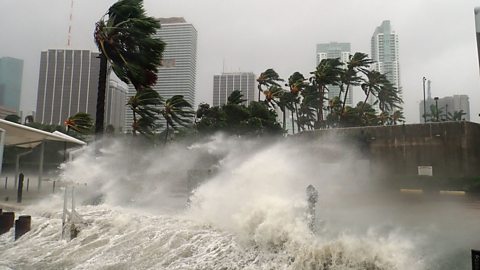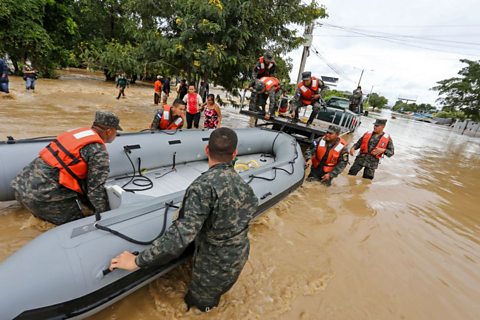What do you know?
What is the name of the layer of the Earth on which we live?
The layer of the Earth on which we live is the crust.
Key points
- The Earth is made of different layers: the core, mantle and crust.
- Plate tectonic theory shows that the crust of the Earth is split into plates (pieces of the Earthâs crust).
- The movement of these tectonic plates leads to earthquakes and volcanoes forming.
The structure of the Earth
The Earth is made up of different layers:
- core (divided into the inner core and the outer core)
- mantle
- crust
| Layer | Description |
|---|---|
| Inner core | The inner core is 2900 km below the Earthâs surface, in the centre of the Earth, and is the hottest layer. It is spherical and solid and made up of iron and nickel. Its temperatures can reach 5500°C. |
| Outer core | The outer core is the layer surrounding the inner core. It is made of liquid iron. |
| Mantle | The mantle is the layer of the Earth which makes up 84% of its volume. It is also the thickest section at approximately 2900 km thick. The mantle is made up of different layers. The upper mantle is hard but below that is semi-molten rock called magma. |
| Crust | The crust is the outer layer of the Earth on which we live. It is the thinnest layer and is between 5 and 90 km thick. |
Question
True or false? There are only two layers of the Earth.
False. The main layers of the Earth are the inner core, outer core, mantle and crust.
Plate tectonic theory
A short film for detailing tectonic plates, their movement and boundaries, and what this means for Earth
Earth is divided into four layers: the inner core, the outer core, the mantle and the crust.
The solid inner core is made of iron and nickel and is as hot as the surface of the sun.
The outer core is also made of iron and nickel but in liquid form. It's also extremely hot.
The mantle is made up of magma, or molten rock.
And the crust is this layer of solid rock that we live on. It's very thin. If Earth was the size of an egg, the Earth's crust would be as thin as the eggshell.
And like an eggshell, the crust has cracked and split into many different pieces called tectonic plates.
These plates can be oceanic, meaning they're found mainly under the ocean, or continental, and mainly found under land.
And they are moved around, constantly fuelled by energy from the very hot mantle below.
Where the movement of currents and the mantle converge, like this, plates are pushed together. This is called a destructive or convergent plate boundary. When the plates collide, the denser plate, usually the oceanic one, is forced underneath the continental plate. The force of this collision is so great that mountains are created.
Earthquakes are very common at this type of boundary as the mountains are pushed upwards by the force of the plates' movement. Tall, steep volcanoes can also form as a result of the denser rock melting and the magma being forced up to the surface.
South America has a great example of a convergent plate boundary. As the Nazca Plate collides with the South American Plate, it's forced underneath it creating the ever-changing Andes Mountains.
Where the movements of the currents in the mantle separate, like this, plates move apart. This is called a constructive or divergent plate boundary. These are usually found under oceans.
As the plate moves apart, magma rises to the surface and cools, forming shallow-sided volcanoes.
The Mid-Atlantic Ridge on the floor of the Atlantic Ocean, where the Eurasian and North American Plates are moving apart, is the perfect example of this.
Plates can also move past each other, like at the San Andreas Fault in the USA, which forms the tectonic boundary between the Pacific Plate and the North American Plate. These are known as Transform Faults.
As the plates scrape past each other, pressure builds up and is released suddenly, causing an earthquake.
The plates of the Earth's crust are constantly moving at about the same speed as your fingernails grow, so the map of the world will continue to change, but just very, very, very slowly.
The crustThe crust is the outer layer of the Earth on which we live. It is the thinnest layer and is between 5 and 90 km thick. of the Earth is not made up of one solid piece â it is split into plates which float on the upper portion of the mantle. There are two types of plate:
- dense oceanic crust
- less dense thick continental crust
These plates move slowly and either move apart, towards or past each other.
The point at which these plates meet is known as a âplate marginâ. It is at the plate margins where the most tectonic activityNatural events that occur as a result of the movement of tectonic plates, such as earthquakes, volcanoes, and mountain building. and tectonic hazardsAn extreme natural event created when the Earthâs crust moves that can cause loss of life, extreme damage to property and disrupt human activities. Tectonic hazards include earthquakes and volcanic activity., such as volcanoes and earthquakes, occur.
Tectonic plates map
There are two theories as to why these plates move. The first, and most common, theory is that the plates move due to convection currentA rising and falling movement of fluid as it heats and then cools. Inside the mantle of the Earth this is caused by the heat of the core. in the Earthâs mantle. This is where the heat from the Earthâs core causes magma to rise. As it nears the Earthâs surface, it then cools and sinks. This circular motion causes the plates in the crust to move.
The second theory is known as âslab pullâ where it is thought that the movement is caused by the weight of heavier denser plates sinking into the mantle and dragging other sections of the plate with it.

Question
Is the Earthâs crust made up of one solid piece?
No, the Earthâs crust is split into a number of separate pieces called plates.
Test your knowledge
Play the Planet Planners game! gamePlay the Planet Planners game!
Make decisions for the planet in this KS3 geography game.

More on Hazards
Find out more by working through a topic
- count2 of 5

- count3 of 5

- count4 of 5

- count5 of 5
